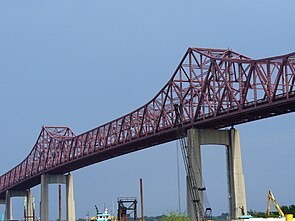Arlington, Jacksonville, Florida
|
Arlington Greater Arlington |
|||||||
|---|---|---|---|---|---|---|---|
| Neighborhood of Jacksonville | |||||||
from the left, Fort Caroline, Jacksonville University, Marabanong mansion, Ribault Monument and the Mathews Bridge.
|
|||||||
|
1. Urban core – city limits before Consolidation
2. Arlington
3. Southside
4. Westside
5. Northside
6. Beaches
|
|||||||
| Coordinates: 30°19′16″N 81°33′05″W / 30.321205°N 81.551487°W | |||||||
| Country | |||||||
| State |
|
||||||
| City |
|
||||||
| Government | |||||||
| • Florida House |
Reggie Fullwood Charles McBurney |
||||||
| • Florida Senate |
Aaron Bean Audrey Gibson |
||||||
| • U.S. House | Ander Crenshaw (R) | ||||||
| Area | |||||||
| • Land | 64.307 sq mi (166.55 km2) | ||||||
| Population (2013) | |||||||
| • Total | 120,593 | ||||||
| • Density | 1,875/sq mi (724/km2) | ||||||
| ZIP Code | 32277, 32211, 32225 | ||||||
| Area code(s) | 904 | ||||||

Approximation of the vernacular areas of Jacksonville:
Arlington is a large neighborhood of Jacksonville, Florida, generally understood as one of the city's large "sides", the others being Northside, Southside and Westside. It borders the Southside area at its southern end, and has several bridge connections to nearby beaches, the Northside and Downtown. The expansive neighborhood was incorporated into the city in 1968 as a result the Jacksonville Consolidation, a city-county consolidation of the governments of the City of Jacksonville and Duval County. Arlington is known for its mid-century modern architecture, and contains several architectural significant homes designed by local architects Robert C. Broward, Taylor Hardwick, and William Morgan.
Arlington was one of the first areas in the United States visited by Europeans; it was the site of the French Fort Caroline in 1564-1565, now represented by the Fort Caroline National Memorial. After the destruction of Fort Caroline, the area was only sparsely inhabited until the 19th century, when sawmills and plantations were established along the St. Johns River. After the American Civil War these gave way to residential developments, which were gradually absorbed into the Arlington community as it grew.
...
Wikipedia





